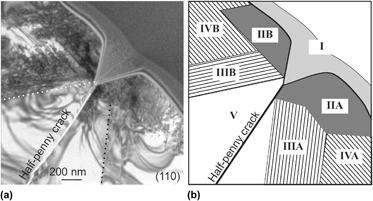Article contents
Nanoindentation cracking in gallium arsenide: Part II. TEM investigation
Published online by Cambridge University Press: 22 October 2013
Abstract

The nanoindentation fracture behavior of gallium arsenide (GaAs) is examined from two perspectives in two parent papers. In the first paper (part I), we address the morphology of the crack field induced by different types of indenters by means of in situ nanoindentation inside a scanning electron microscope (SEM) and of cleavage cross-sectioning techniques. In the present paper (part II), we investigate the early stage of crack nucleation under wedge nanoindentation through cathodoluminescence and transmission electron microscopy. We find that the apex angle of the wedge indenter influences the dislocation microstructure and, as a consequence, the mechanism of crack nucleation under nanoindentation. The formation of microtwins depends on both the orientation of the indenter with respect to the orientation of the GaAs crystal and on the apex angle of the indenter. For dicing applications of GaAs wafers, it is desirable to have an opening angle of the indenter smaller than 70° to facilitate the formation of precursor cracks.
- Type
- Articles
- Information
- Copyright
- Copyright © Materials Research Society 2013
References
REFERENCES
- 6
- Cited by




